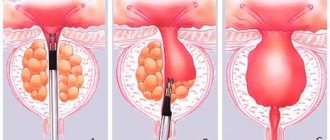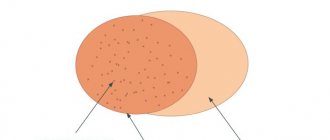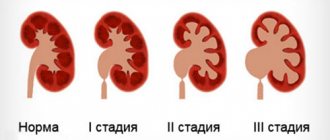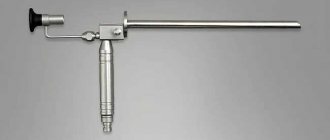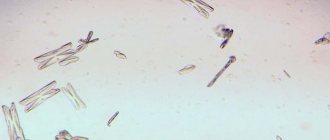The most common urological pathology for which men over 45 years of age consult a urologist at the Yusupov Hospital is prostate adenoma. The presence of this pathology significantly worsens the quality of life of men. One of the most dangerous possible consequences of the pathological process is the degeneration of benign prostatic hyperplasia into a malignant tumor.
To combat prostate adenoma, surgical and drug treatment methods are used. Specialists at the Yusupov Hospital select the most effective medications or surgical methods taking into account the stage of the disease, the general condition and age of the patient, as well as the presence of concomitant pathologies. The surgery clinic has created comfortable conditions for treating patients.
Causes of development of prostate adenoma
The occurrence of adenoma is most often associated with age-related changes in the prostate, namely, changes in its structure and increase in size.
As a result of such changes, the urethra, which is located in the thickness of the prostate gland, is gradually compressed and disturbances in the urination process appear. Prostate adenoma in men develops as a result of hormonal changes in the body associated with age-related changes. The level of testosterone (male hormone) gradually decreases with age, while the concentration of the female sex hormone (estrogen), on the contrary, increases. This phenomenon is called male menopause.
The development of prostate adenoma may be due to the following risk factors:
- The age of the patient - an enlarged prostate gland is extremely rarely found in men under forty years of age, and after sixty years of age it is diagnosed in almost every second one;
- Hereditary predisposition - if prostate adenoma was diagnosed in close blood relatives of a man, he has a huge risk of inheriting this disease in adulthood;
- Diabetes mellitus, cardiovascular diseases - a benign tumor (adenoma) of the prostate can arise not only as a result of these diseases themselves, but also the harmful effects of medications for their treatment (for example, beta blockers);
- Improper lifestyle – the risk of developing prostate adenoma is increased in men with obesity and insufficient physical activity.
Make an appointment
Symptoms of prostate adenoma
Prostate adenoma in men can be suspected when a man develops the following symptoms, the most typical for this disease:
- increased urge to urinate;
- the need to tense the abdominal muscles to urinate;
- the presence of painful sensations, burning, sluggish stream of urine;
- discomfort and insufficient emptying of the bladder;
- increasing the duration of the urination process.
Prostate adenoma leads not only to a decrease in a man’s quality of life, but also to acute urinary retention, which requires the use of surgical treatment methods.
To avoid surgery, many patients use special medications to treat prostate adenoma, eliminating symptoms and restoring normal prostate function. However, only a qualified specialist can suggest the best remedy for prostatitis and prostate adenoma. You should contact him when the first symptoms of the disease appear. Treatment of prostate adenoma is individual for each patient. Drugs for the treatment of prostate adenoma, their dosage and duration of use are prescribed by the attending physician. Taking medications for prostatitis and prostate adenoma on your own can be not only ineffective, but also dangerous. Due to the presence of some “personal” chronic diseases in older men, drugs for the treatment of prostate adenoma in older people should be selected taking into account concomitant pathologies.
Prostate adenoma in facts and figures:
- BPH is quite common, affecting about half of men age 75 and older.
- Eventually, benign prostatic hyperplasia occurs in approximately 85% of men as they age. In the remaining 15%, changes also occur in the gland.
- There is a point of view according to which this condition is a normal sign of aging, a kind of manifestation of the “male menopause.”
- Prostate adenoma is not cancer. It does not grow into neighboring tissues and organs and does not metastasize.
How does prostate adenoma develop?
Prostate adenoma is characterized by gradual development, which can be divided into three stages.
- The first stage of the disease occurs with minimal urination disturbances. There may be a slight increase in frequency, especially at night, and a sluggish stream of urine. The first stage can last from one year to 12 years or more.
- The second stage of prostate adenoma is characterized by more pronounced urination disorders: intermittent urine stream, the need to strain when urinating and a feeling of incomplete emptying of the bladder. Residual urine, which is retained in the bladder and urinary tract, causes an inflammatory process, which is accompanied by pain, a burning sensation when urinating, pain in the lumbar region and above the pubis.
- The third stage is characterized by periodic or constant involuntary leakage of urine, which forces the patient to use a urinal.
Complications of prostatitis
In some men, prostate adenoma does not impair the quality of life and proceeds without complications. However, in some cases, the disease can cause the following negative consequences:
- Acute urinary retention - it is characterized by a sudden inability to empty the bladder and pain in the suprapubic region. In such a condition, the patient requires emergency medical care with catheterization or minor surgery;
- The occurrence of infections in the urinary tract - stagnation of urine, which creates favorable conditions for the proliferation of pathogens, leading to the development of cystitis and pyelonephritis;
- The formation of stones in the bladder is also a consequence of stagnation of urine;
- Damage to the bladder - when the bladder is not emptied regularly, it stretches and formation of protrusions (pockets) in the walls of the organ in which urine stagnates;
- Kidney damage – increased pressure in the ureters and bladder has a direct damaging effect on the kidneys, resulting in renal failure.
Prostate adenoma and potency
Prostate adenoma and potency are closely interrelated. Adenoma disrupts the structure of the gland tissue, which, in turn, leads to damage to another, no less important organ - the testicles, which are responsible for the production of androgens. Thus, prostate adenoma can cause impotence, requiring long-term and complex therapy.
Diagnostics of the XXI century!
The most advanced method for diagnosing male problems is magnetic resonance imaging (MRI). MRI is performed if there is a suspicion of space-occupying formations in the pelvic area.
ON CLINIC has the latest MRI equipment, created by SIEMENS.
MRI has no “equal” in terms of accuracy, speed and information content in obtaining the most valuable diagnostic information.
A prostate examination at ON CLINIC using MRI is carried out in a matter of seconds. In this case, the entire area of interest is examined, associated complications are identified, and the feasibility of surgical intervention is determined.
Diagnosis of the prostate gland in men
A simple and effective way to establish a preliminary diagnosis is for the patient to keep a diary of urination, recording quantitative and qualitative parameters: volumes of urine excreted, characteristics of fluid consumed, imperative urges, night urges. The main physical examination method for suspected prostate adenoma is a digital rectal examination of the prostate to detect its enlargement and exclude some other pathologies. Diagnosis of prostate adenoma at the Yusupov Hospital is carried out using the following laboratory and instrumental methods:
- General blood and urine tests;
- Biochemical blood test for markers of kidney condition, urea and creatinine levels;
- PSA level analysis (to rule out prostate cancer);
- Transrectal ultrasound examination (ultrasound);
- Uroflowmetry (to determine the speed of urine flow);
- Determination of residual urine volume (using ultrasound);
- Electromyography of the pelvic floor;
- Urethrocystoscopy;
- Excretory urography.
Treatment of prostate adenoma without surgery using minimally invasive methods
Minimally invasive methods for treating prostate adenoma are used relatively rarely, since despite their safety, they are less effective than surgery.
Today, treatment of prostate adenoma without surgery can be carried out using the following minimally invasive methods:
- thermal method - the most used of these methods is transurethral microwave thermotherapy. Involves heating the prostate using microwave, radio frequency, and ultrasound radiation;
- cryodestruction method - destruction of altered prostate tissue by cold;
- laser method - through laser exposure, the liquid part of the prostate tissue is heated, after which water evaporates (vaporization) and the surrounding cells shrink;
- balloon dilatation of the urethra - artificial expansion of the lumen of the urethra, into which a catheter equipped with an air balloon is inserted;
- the method of stenting the prostatic urethra - inserting a stent, which is a thin cylindrical frame into the urethra to facilitate the outflow of urine.
The use of the above-described methods of non-surgical treatment of prostate adenoma cannot ensure a complete recovery of the patient, but it guarantees a temporary improvement in well-being and prevention of the development of an inflammatory process in the urinary tract.
For obvious reasons, patients are looking for ways to avoid surgery and how to treat prostate adenoma without surgery. However, the decision on the method of treatment for this pathology should be made only by a urologist who is familiar with the results of the patient’s examination. In some cases, conservative therapy can truly be a salvation, but in others it can only cause harm, since precious time is often lost and the operation has to be performed for emergency reasons.
You can get advice from a competent, experienced urologist, carry out high-quality diagnostics and effective treatment of prostate adenoma at the Yusupov Hospital. This is a multidisciplinary medical center equipped with the latest diagnostic equipment, which, coupled with the high competence of our diagnosticians, guarantees accurate research results. For each patient, the clinic’s urologists select the most effective individual treatment regimen using modern medications or innovative minimally invasive techniques.
Treatment of prostatitis - the most effective methods
Treatment of prostate adenoma is aimed at relieving symptoms of the lower urinary tract, improving the patient’s quality of life and preventing the development of complications of the disease. Patients with mild symptoms that do not impair the quality of life are often prescribed dynamic monitoring with regular examinations by a urologist, who monitors the course of the disease and gives recommendations on how to stop the growth of prostate adenoma. During this period, attention is focused on non-drug therapy. The methods described above can be an addition to conservative treatment, which consists of taking the following medications:
- Alpha blockers (Tamsulosin, Alfuzosin);
- 5-alpha reductase inhibitors (Finasteride);
- Phosphodiesterase type 5 inhibitors (Sildenafil);
- Combinations of 5-alpha reductase inhibitors and alpha blockers;
- Muscarinic receptor blockers or M-anticholinergics.
For patients with advanced stage prostate adenoma, surgical treatment is recommended, which can be performed by several methods: transurethral excision, transurethral resection and removal of the prostate.
There are certain indications for the use of surgical treatment:
- Recurrent urinary retention;
- Renal failure caused by prostate adenoma;
- Bladder stones;
- Recurrent urinary tract infections;
- Recurrent hematuria.
In addition, surgical intervention is necessary for patients in the absence of effectiveness of drug treatment.
During conservative therapy or in the postoperative period, patients require constant medical supervision with standard studies (determination of urine flow rate, ultrasound, analysis of PSA levels).
Make an appointment
Hormonal treatment of prostate adenoma without surgery
Due to the existence of an endocrine theory of the pathogenesis of prostate adenoma, hormones that prevent the accumulation of dihydrotestosterone are sometimes used in the treatment of the disease.
- antiandrogens;
- estrogens;
- progesterone derivatives.
Estrogen inhibits the enzyme 5-alpha reductase and switches androgen metabolism to the oxidation pathway. In addition, it creates a blockade of alpha-androstenedione, as a result of which hypertrophy and hypersecretion of glandular cells of the prostate parenchyma develop. Complex drug therapy includes taking the drugs 17-hydroxy-19-norprogesterone-capronate, Depostat.
The use of hormonal therapy in the treatment of prostate adenoma is currently disputed by many modern urologists, who justify their use only as part of complex treatment or in the presence of contraindications to surgical intervention.
Drugs for the treatment of prostatitis and prostate adenoma
There is a certain scheme according to which specific drugs are prescribed for the treatment of prostatitis and prostate adenoma.
High effectiveness of treatment is achieved through the use of drugs from the group of alpha-reductase inhibitors and alpha-blockers. These drugs for the treatment of prostate adenoma in men help eliminate the main symptoms of the disease, as well as restore sufficient urination. What are the most effective and widely used tablets for prostate adenoma? The list is topped by alpha1-adrenergic receptor blockers. In addition, this list includes 5-alpha reductase inhibitors, vitamins and minerals.
The complex of drug therapy includes not only drugs. For prostate adenoma, conservative treatment can be supplemented with biologically active additives - dietary supplements, which enhance the therapeutic effect of drugs and ensure a speedy recovery. Some of them contain zinc. This macroelement is directly involved in spermatogenesis and testosterone synthesis. Plant phytosterols normalize urination.
Treatment with drugs from the group of alpha1-adrenoceptor antagonists
These drugs for the treatment of prostatitis and prostate adenoma provide relaxation of the smooth muscles of the urinary system and improve the process of urine discharge.
Tamsulosin, with the same name as the active substance, which is included in other drugs (Alfuzosin, Omnic, Silodosin, Urorek, etc.), is a highly selective drug that has a selective effect on alpha1-adrenergic receptors of the muscles of the prostate gland, prostatic urethra and bladder. Due to the decrease in muscle tone, the outflow and excretion of urine is facilitated. Tamsulosin, like all selective drugs, has minimal side effects, does not affect vascular tone and can be prescribed to patients with chronic hypertension. Alpha-adrenergic antagonists must be used continuously, thereby achieving a gradual reduction in irritation and obstruction in prostate adenoma. The drug Omnic in the treatment of prostate adenoma occupies a well-deserved priority in the prescriptions of urologists. It is produced by the Japanese company Astellas Pharma in the form of capsules and tablets (Omnic Okas). How long can you take Omnic without interruption? This directly depends on the stage of the disease. It is strongly recommended that for the risk of exceeding the dosage, consult your doctor about taking the drug and its dosage limits.
The tablet form of the drug is considered more progressive, since thanks to the controlled release of tamsulosin, the active substance is in the body in a constant concentration. The medicine enters the bloodstream evenly, thereby reducing the likelihood of developing the main side effect of drugs from the adrenergic blocking group - a sharp decrease in blood pressure.
An equally effective drug with the active ingredient tamsulosin is Urorek. Taking this drug is not accompanied by the following undesirable effects: orthostatic hypotension, tachycardia, increased frequency of angina attacks in patients with coronary heart disease, so it can be prescribed to men with cardiac pathologies. Properly selected dosage and compliance with all rules for the use of drugs from the alpha-blocker group make it possible to achieve a good therapeutic effect with an almost complete absence of side effects.
Medicines from the group of reductase inhibitors (blockers)
Drugs of this pharmacological group (Finasteride, Penester, Alfinal, Dutasteride, Avodart) help facilitate the outflow of urine, and, therefore, eliminate the main symptoms of the disease.
A stable therapeutic effect occurs within two to three weeks after the start of the course. All symptoms disappear completely after three months. According to the results of clinical studies, maximum effectiveness is achieved after six months of therapy with these drugs. Finasteride and Dutasteride are specific inhibitors of type 2 5-alpha reductase (the cellular enzyme responsible for the transformation of testosterone into dihydrotestosterone). The growth of the prostate gland in prostate adenoma is directly related to a similar transformation of testosterone. Thanks to 5-alpha reductase inhibitors, the production of intraprostatic dihydrotestosterone is blocked and its concentration in the blood is significantly reduced.
Finasteride and Dutasteride are used for the following purposes:
- Treatment and control of prostatic hyperplasia;
- Improving the outflow of urine and eliminating the symptoms of prostate adenoma;
- Reducing the risk of developing acute urinary retention and the need for surgical intervention.
Finasteride and Dutasteride have a pronounced antiandrogenic effect, i.e. help reduce the level of male hormones in the blood. In addition, these drugs have a teratogenic effect, so they should be taken with caution. With the help of modern medications, it is possible to stop the growth of the prostate and prevent the need for surgical treatment.
Free consultation with a urologist
Modern methods of treating prostate adenoma include minimally invasive surgical techniques that can be performed using laser, ultrasound, and electrovaporization to remove hyperplastic prostate tissue. Minimally invasive surgical techniques provide a more pronounced therapeutic effect compared to drug therapy, but, nevertheless, they cannot surpass the “gold standard” of surgical treatment - transurethral resection of the prostate gland.
The American Urological Association recommends the use of minimally invasive techniques in men with moderate to severe symptoms of prostate adenoma, as well as in the presence of severe concomitant pathology that does not allow transurethral resection of prostate adenoma (TURP). In addition, modern methods of treating prostate adenoma are resorted to in case of ineffectiveness of drug therapy.
Treatment is carried out on an outpatient basis and requires local or regional anesthesia, rarely general anesthesia. All minimally invasive surgical procedures are performed endoscopically using a transurethral approach (that is, through the urethra). A few hours after the operation, the man can be discharged home.
To better understand modern methods of treating prostate adenoma, we will explain the meaning of some of the concepts below:
Ablation – removal, excision. The word ablation comes from the Latin “ablatum” - taking away. Historically, the word ablation was used to mean “elimination of disease.” However, since 1846, the concept of ablation began to be used as a surgical term denoting the removal of any part of the body or organ.
Enucleation is a term that also came to us from the Latin language, “enucleate” - to extract. Enucleation is a surgical procedure that involves removing an entire organ or tumor without cutting out adjacent tissue.
Vaporization is a physical term denoting the transformation of a substance from a liquid or solid phase into a gaseous phase. Vaporization of the prostate – evaporation of water from the tissues of the prostate gland under the influence of high temperatures.
Modern methods of treating prostate adenoma include the following minimally invasive procedures:
TUNA : Transurethral Needle Ablation
Transurethral needle ablation is a type of minimally invasive outpatient surgery that uses radio waves to heat and destroy the part of the prostate gland that is compressing the urethra. Before treatment, the doctor uses an ultrasound to determine the exact size of the prostate. To perform transurethral needle ablation, the urologist inserts an endoscopic instrument into the urethra and advances it to the point where the urethra is being compressed by the enlarged prostate. When the instrument is in the desired position, needles are passed through the lumen along a special guide into the hyperplastic tissue, delivering high-temperature (110 °F) low-frequency radio waves that isolatedly destroy the prostate tissue surrounding the urethra.
At the same time, coagulation of blood vessels occurs - this prevents the development of bleeding. As a result of the procedure, the narrowed urethra widens, which leads to relief of the symptoms of prostate adenoma.
However, it is worth noting that the disappearance of all symptoms occurs with complete destruction of the prostate, so often after the procedure the symptoms of prostate adenoma may partially persist. Another disadvantage of this procedure is that repeat transurethral needle ablation procedures are often required after several years as the prostate continues to increase in size. According to clinical studies, in 14% of cases, men require repeated needle ablation procedures every two years to combat the symptoms of prostate adenoma. In addition, transurethral needle ablation is ineffective in men with a significantly enlarged prostate. This procedure is not widely used.
TUMT : Transurethral Microwave Thermotherapy
Transurethral microwave thermotherapy is a modern method of treating prostate adenoma, based on the use of a combination of heat and cold energy to reduce the symptoms of prostate adenoma. Just like TUNA, transurethral microwave thermotherapy can be performed in an outpatient setting. Using endoscopic instruments, a catheter is inserted through the urethra into the prostate, into which a special antenna is built-in, sending microwaves that cause heating and destruction of hyperplastic prostate tissue.
At the same time, cold water circulates through the catheter, which protects healthy prostate tissue from destruction, reduces the discomfort associated with the procedure, and reduces the risk of developing unwanted effects.
Transurethral microwave thermotherapy takes about an hour on average and can be performed under light sedation or even while fully conscious. After the procedure, a catheter is left in the urethra for 1-3 days. This procedure is most effective in men with moderate symptoms of prostate adenoma and no history of episodes of acute urinary retention. Only a few weeks after the procedure, men notice relief from the symptoms of prostate adenoma, and the full effect of transurethral microwave thermotherapy develops after 90 days.
PVP: Photoselective Vaporization
Photoselective vaporization also refers to modern methods of treating prostate adenoma. A high-energy green laser (potassium titanyl phosphate, or KTP laser) introduced through the urethra and creating a high temperature vaporizes the hyperplastic part of the prostate gland, which is compressing the urethra. The use of photoselective vaporization is justified in men with a prostate up to 60 grams in size. The laser evaporates excess prostate tissue, while no necrotic (dead) prostate tissue remains in the lumen of the urethra. In addition, under the influence of a green laser, coagulation of bleeding vessels occurs, which reduces the risk of bleeding to a minimum. The operation can be performed on an outpatient basis and takes no more than 30 minutes.
HIFU : High Intensity Focused Ultrasound
High Intensity Focused Ultrasound is a minimally invasive technology that uses focused ultrasound waves to briefly (2-3 seconds) heat (up to 195°F) and destroy prostate tissue. At the same time, adjacent tissues remain intact.
HoLEP : Holmium laser enucleation of prostate adenoma and HoLAP : Holmium laser ablation of prostate adenoma
Holmium laser enucleation/ablation of prostate adenoma uses laser energy to remove hyperplastic prostate tissue, relieve urethral obstruction and relieve symptoms of the disease. In addition, the holmium laser can be used to break up and remove bladder stones.
It is currently believed that holmium laser ablation may be an alternative to transurethral resection of prostate adenoma. Choice of procedure, i.e. HoLEP or HoLAP, depends only on the size of the prostate. Ablation is performed if the size of the prostate gland is less than 60 cubic centimeters, while enucleation is used for larger prostate glands.
Delivery of holmium laser energy to the prostate tissue is carried out using a thin flexible laser fiber passed through the urethra using an endoscopic instrument. The duration of the holmium laser ablation of prostate adenoma (HoLAP) procedure is on average one hour. After the holmium laser ablation of prostate adenoma (HoLAP) procedure, a urinary catheter is not required, and the man can be discharged home within a few hours after the operation. Pain and infectious complications after the procedure are extremely rare. According to clinical studies, only 2% of men required re-treatment of prostate adenoma after holmium laser ablation of prostate adenoma (HoLAP). In addition, this modern method of treating prostate adenoma does not affect the erectile function of a man, and the recovery period takes only a few days. During the first time after surgery, a man may experience urinary incontinence, but long-term incontinence after holmium laser ablation of prostate adenoma (HoLAP) is observed in only 1% of cases.
Interstitial laser therapy
Interstitial laser therapy (interstitial laser coagulation) is a modern method of treating prostate adenoma, based on the use of laser energy to heat and destroy prostate tissue that causes obstruction of the urethra. An endoscopic instrument is inserted into the urethra; a laser fiber is passed through its lumen into the hyperplastic tissue, emitting energy and destroying tissue that blocks the flow of urine.
Interstitial laser therapy is associated with minimal blood loss and does not lead to the development of retrograde ejaculation or erectile dysfunction. Like other modern methods of treating prostate adenoma, interstitial laser coagulation is performed on an outpatient basis under local anesthesia. After the procedure, a urinary catheter is required for several days. Reduction in symptoms of prostate adenoma occurs 6-12 weeks after the procedure.
Stenting
A stent is a small cylindrical structure that is inserted into the prostatic part of the urethra, as a result of which the lumen of the urethra expands and the obstacle to the free flow of urine is removed. To place a stent, it must be passed through the urethra to the site of narrowing using endoscopic equipment, and no incisions or the use of thermal or laser energy are required. As a rule, stenting is a temporary solution to the problem, and for some men, placing a stent is not possible at all. The success rate of urethral stenting ranges from 50 to 90%, and the procedure is associated with a high risk of complications. Stent placement may be an alternative for men who cannot take medications to treat BPH or whose risks of surgery are greater than the benefits.
Balloon dilatation
Balloon dilatation, like stenting, is an alternative procedure for men in whom surgery is associated with high risk.
The procedure involves using a cystoscope to insert a special catheter with a balloon at the end into the prostatic part of the urethra, which, when inflated, expands the lumen of the urethra. According to recent studies, the majority of patients who underwent balloon urethral dilatation noted a rapid return of prostate adenoma symptoms, and repeat dilation was required two years after the first procedure. Currently, due to the existence of more effective modern methods of treating prostate adenoma, balloon dilatation is used extremely rarely. Advantages of minimally invasive techniques:
- Possibility of performing the procedure on an outpatient basis
- Successfully replace drug treatment of prostate adenoma
- Short recovery period after the procedure
Disadvantages of modern methods of treating prostate adenoma:
- The impossibility of conducting a histological examination of destroyed tissue to exclude prostate cancer
- Less pronounced therapeutic effect compared to transurethral resection of the prostate
- The relatively short period of use of these techniques, and, consequently, the lack of data on long-term treatment results.
Transurethral resection of prostate adenoma – TUR of the prostate
Since 1909 to the present day, transurethral resection of prostate adenoma (TURP) has been the “gold standard” for the treatment of prostate adenoma. Transurethral resection of prostate adenoma is the very first and successful minimally invasive surgical procedure among other modern methods of treating prostate adenoma. Despite the fact that transurethral resection of prostate adenoma has been used in urology for quite a long time, the developed innovative medical technologies have made it possible to significantly improve the technique of transurethral resection of prostate adenoma (TURP). It is thanks to the improvement of equipment and surgical techniques that transurethral resection of prostate adenoma can be classified as a modern method of treating benign prostatic hyperplasia.
The main achievement of medical technology is the advent of bipolar transurethral resection of prostate adenoma.
Previously, a monopolar resectoscope was used to perform transurethral resection of prostate adenoma (TUR of the prostate). During monopolar TUR of the prostate, current flows between the active electrode (it is connected to the resectoscope loop) and the grounding pad located under the patient, which creates the risk of skin burns, excessive heating deeper located tissues and disruption of the conduction system of the heart. In addition, monopolar transurethral resection of prostate adenoma requires irrigation of the surgical field with hypoosmolar fluids, which creates the risk of developing TUR syndrome - systemic absorption of a large volume of hypoosmolar fluid. Bipolar transurethral resection of prostate adenoma allows you to resect hyperplastic tissue with a lower risk of complications, including systemic absorption of hypotonic fluid. Bipolar transurethral resection of prostate adenoma is carried out using a resectoscope, in which current flows between the active and passive electrodes, the resulting radiofrequency energy converts the isotonic irrigant into a plasma layer that destroys prostate adenoma cells.
It is also worth noting that the creation of high temperature in the resection area provides excellent hemostasis of the postoperative wound.
‹ Surgeries for prostate adenoma Up Treatment of prostate adenoma with laser ›
Antispasmodics and painkillers for exacerbation of the disease
The main purpose of antispasmodic and analgesic drugs during exacerbation of prostate adenoma is to alleviate the general condition of the patient and eliminate pain.
Non-steroidal anti-inflammatory drugs (Diclofenac, Ibuprofen) have an anti-inflammatory and analgesic effect. They help fight not only the pain that occurs during urination, but also the constant pain in the groin and perineum. Thanks to the action of non-steroidal anti-inflammatory drugs, the inflammatory process is reduced, swelling of the prostate gland is reduced, body temperature is normalized, and unpleasant symptoms are eliminated. Non-opioid analgesics, available in the form of tablets or suppositories, help relieve pain during exacerbation of prostate adenoma. The most accessible of them is Analgin. However, this drug is intended rather for one-time use, since it can only affect mild pain. In addition, analgesics with lidocaine, benzocaine, anesthesin and novocaine (Ichthyol, Anestezol, Procto-Glivenol) are effective.
Vitamin E 400
Tocopherol acetate or vitamin E is often included in the complex treatment of prostate adenoma as an antioxidant, radioprotective agent and an indispensable link in reproductive processes.
Vitamin E in a dosage of 400 mg is prescribed by urologists to patients with disorders of erectile function and spermatogenesis associated with prostate adenoma. Treatment of such a serious chronic disease as prostate adenoma should be prescribed and monitored by a urologist. Taking certain medications on your own, without prior consultation with your doctor, is strictly prohibited, since self-medication in this case may not only be ineffective, but also dangerous for men’s health. Only a qualified specialist can tell you which tablets for prostate adenoma are the most effective in each specific case, and which of them can cause negative consequences.
What tests do I need to undergo first?
Treatment regimens for prostate adenoma vary depending on the size of the gland, the age of the man and the level of prostate-specific antigen (PSA), which is found only in the prostate gland in the body. Determining PSA levels is used to diagnose prostate cancer, and it is the results of this test that the doctor will primarily take into account.
In addition, when examining a man, the urologist must collect information about the volume of the prostate gland. An experienced doctor can determine an enlarged prostate by palpating it with a finger through the rectum.
The exact volume of the gland and the volume of residual urine are measured by ultrasound. The volume of the gland is more than 30 cubic meters. cm is considered an increase. The residual urine rate should be no more than 50 ml.
Before visiting a urologist, a man over 40 years of age must take a PSA blood test. If a man has not taken this test, the urologist prescribes it and explains how to properly prepare for donating blood for PSA. After receiving the result, the man comes for a second consultation. The urologist analyzes the information received and recommends treatment or further examination.
Operations
Urologists at the Yusupov Hospital masterfully perform classical and minimally invasive surgical interventions and use innovative methods of surgical treatment of prostate adenoma.
Each patient is selected for the operation that suits him best. The generally accepted standard in the surgical treatment of prostate adenoma is transurethral resection of the prostate. The operation is highly effective. After the intervention, patients get rid of bladder outlet obstruction (narrowing of the urethra) and associated symptoms. The rehabilitation period is short. During or after surgery, bleeding and “water intoxication” syndrome may develop in the body.
Alternative methods of treating prostate adenoma include the following surgical interventions:
- Stenting;
- Balloon dilatation;
- Hyperthermia;
- Thermotherapy;
- Ultrasound, laser and needle ablation;
- Interstitial coagulation.
After them, complications occur less frequently, but these techniques are inferior to transurethral resection in terms of effectiveness, both clinically and economically.
Laparoscopic removal of prostate adenoma is used when the tumor has grown significantly, and removing it using transurethral resection is problematic. This operation is more complicated and is performed under anesthesia. Through small incisions, the surgeon inserts special instruments into the body cavity, which are used to remove the prostate adenoma. The operation is carried out using images from video cameras, which are displayed on the screen. The main advantages of the intervention are minimal blood loss and low likelihood of complications. After the operation, the patient does not need long-term rehabilitation.
When there are signs of prostate adenoma in men, doctors use a high-tech method of treating adenoma - laser enucleation. The intervention is carried out when the tumor is large. Excess tissue is removed using a laser. The operation is performed through the urethra. The tumor is separated, divided into small parts, and then removed. The method is considered minimally invasive. It has a number of significant advantages: it does not violate the integrity of cavities and does not cause unnecessary damage.
Laser vaporization involves destroying the adenoma by laser evaporation. The urologist inserts a special device through the urethra, brings it to the tumor and precisely targets it with a strong green laser. The depth of penetration of the laser and the accuracy of its impact make it possible to avoid damage to neighboring areas. The method is minimally invasive, bloodless, fast and effective. Its only drawback is the inability to take tumor tissue for histological examination.
In some situations, the inevitable method of treating prostate adenoma is abdominal surgery - adenomectomy. It is performed when other methods cannot help the patient. During surgery, the surgeon uses a scalpel to access the prostate gland and manually, using surgical instruments, removes the adenoma. As a result of the operation, significant blood loss and complications may develop. After surgery, the patient needs long-term rehabilitation.
Removal of prostate adenoma using transvesical (transvesical) adenomectomy involves radical excision of hyperplastic prostate tissue through a longitudinal incision in the anterior abdominal wall and bladder. The operation is performed in advanced stages of the disease, when the tumor reaches a large size, the bladder is overstretched due to its overflow with accumulated urine, and renal failure develops.
The bladder is pre-catheterized and filled with a sterile solution of furatsilin or another substance. Then it is isolated and taken in two places on special holders, for which the wall of the organ is lifted. The surgeon cuts through the resulting fold and opens the bladder.
Along the inner end of the installed urinary catheter, the area of the bladder neck is determined and around the urethral opening that appears in the field of view, stepping back from it by 0.5-1 cm, an incision is made in the mucous membrane. After this, the operating urologist penetrates the thickness of the prostate with his finger, enters it between the tumor capsule and adenomatous nodes, and removes the latter. At the same time, with the finger of the other hand, which is first inserted into the patient’s rectum, the doctor moves the gland towards the anterior abdominal wall. It becomes more accessible to manipulation. Thanks to this technique, the operation time is reduced and blood loss is reduced.
Then the surgeon performs hemostasis (stopping bleeding) of the bed of the removed adenoma and suturing the bladder, leaving a thin drainage in the wound. It is designed to wash its cavity from formed blood clots. The urinary catheter inserted before the operation is not removed for 7-10 days. A new section of the urethra is formed around it instead of the prostatic part of the urethra excised during the operation.
Transvesical adenomectomy is one of the most traumatic of all techniques used for prostate adenoma. It is accompanied by the risk of developing the following complications:
- Bleeding from the tumor bed;
- Congestive pneumonia;
- Violation of the motor-evacuation function of the intestines, manifested by constipation.
To avoid complications, after surgery at the Yusupov Hospital, the patient undergoes early activation. The following undesirable consequences of surgery to remove prostate adenoma may occur:
- Insufficient drainage of the bladder;
- Narrowing of his neck;
- Urinary infiltration of peri-vesical tissue;
- Formation of a “pre-bladder” (residual cavity in the place where the prostate adenoma was removed);
- Formation of narrowing of the lumen of the urethra;
- Urinary incontinence.
This negatively affects the quality of life of patients and prolongs the time required to restore adequate urination.
The consequences of the operation are less pronounced when the intervention is performed using a laparoscope. Laparoscopic surgery to remove prostate adenoma is one of the less invasive options for surgical interventions on the prostate gland. Urologists at the Yusupov Hospital use this technique if the patient has a sufficiently large prostate adenoma.
If the size of the prostate gland of a patient with adenoma does not exceed 120 cm3, transurethral resection of the prostate adenoma is recommended. But for 10% of patients who need surgical intervention, this option is not suitable, since the gland reaches a size of more than 120 cm3. Laparoscopic surgery to remove prostate adenoma is not performed for urolithiasis, inguinal hernia, bladder diverticula, or ankylosis of the joints of the lower extremities. In this case, the decision on the possibility of performing an operation is made collectively by a urologist, andrologist, abdominal surgeon and other specialists at the Yusupov Hospital.
With laparoscopic access, general anesthesia is used. Laparoscopic removal of prostate adenoma is carried out using specialized equipment. The surgeon uses trocars through which he passes laparoscopic instruments to the prostate gland. The trocar is equipped with a small video camera that transmits the image to the screen. This way, surgeons have the opportunity to perform all actions as accurately as possible.
Laparoscopic surgery to remove prostate adenoma has the following advantages over open adenomectomy:
- During the operation, bleeding and complications occur much less frequently;
- The pain syndrome is less pronounced, the patient does not need a large amount of analgesics;
- Bladder catheterization does not last long;
- Physical activity is restored faster, the next day after the operation the patient can walk without difficulty.
- Hospitalization after laparoscopic adenomectomy takes much less time. The patient quickly returns to normal life. He has no cosmetic problems. The length of scars after surgery does not exceed one centimeter.
After laparoscopic removal of prostate adenoma, the need for repeated surgery is minimized, since a significant part of the prostate tissue is removed.
Embolization of prostate arteries is one of the most modern methods of treating adenoma. It is used more often abroad. The operation involves blocking the blood vessels supplying the prostate adenoma. An endovascular surgeon for large blood vessels brings a microcatheter to the source of blood supply to the tumor and injects a special composition that blocks the blood flow. As a result, the tumor does not receive oxygen and nutrients, and it decreases in size. Contraindications to the use of this method are malignant tumors, allergies to contrast and embolic agents, cardiovascular pathology, some chronic diseases of internal organs, and acute diseases.
Transurethral resection of the prostate (TURP) is a method of removing prostate adenoma without external incisions. The intervention is performed using a special instrument (resectoscope). The urologist inserts it into the patient’s bladder through the urethra. After examining the urethra, bladder and the actual area where the prostate adenoma is located (the border of the urethra and bladder), the surgeon removes the prostate adenoma using a special device - a loop. Transurethral resection of the prostate requires good visibility. It is ensured by a constant flow of fluid through one of the resectoscope channels and outflow through the other channel. Visibility may be impaired due to bleeding from blood vessels. During the operation, the surgeon stops the bleeding in order not to lose orientation in the tissues.
Transurethral resection of the prostate is used if the size of the prostate gland does not exceed 80 cm3. The adenoma is removed until the tissue of the gland itself is visible. After the prostate adenoma is removed, the tissue is washed from the bladder using a special instrument, and a control examination of the surgical site and the bladder is carried out. If necessary, additionally stop bleeding from blood vessels. After this, the surgeon removes the operating instrument (resectoscope). A special Foley catheter is passed through the urethra into the bladder. An inflating balloon is located at the bladder end of the catheter. After the catheter is inserted into the bladder, the balloon is filled with fluid. It takes the place of the removed adenoma, which helps stop bleeding from small vessels and prevents the catheter from falling out of the bladder. In this case, minimal consequences are observed after removal of the prostate adenoma. Patient reviews of the operation are excellent. Recovery after removal of prostate adenoma occurs quickly.
Transurethral resection of the prostate is one of the most complex and precious operations in the entire spectrum of endoscopic urological surgery. Urologists at the Yusupov Hospital have undergone special training. Surgeons are fluent in the technique of this surgical intervention.
Transurethral electrovaporization combines the advantages of standard transurethral resection (the possibility of immediate removal of tumor tissue, optical control of the intervention, clinical and economic efficiency) with a significant reduction in blood loss during and after surgery, preventing “water intoxication” of the body. Electrovaporization of the prostate also has disadvantages. “Roller vaporization” is technically simple, there is good endoscopic visibility, there is no bleeding, but, compared to monopolar transurethral resection, it has a lesser ability to remove hyperplastic tissue. Roller vaporization is used as monotherapy for prostate adenoma with a volume of no more than 40 cm3. Vaporizing resection is not inferior in efficiency and speed to standard transurethral resection. It is just as difficult to master, since the hemostatic effect of the vaporizing loop is not as pronounced as the “roller vaportrode”, and the technique of cutting and removing prostate adenoma requires considerable experience of the surgeon.
New methods of transurethral endoscopic treatment of prostate adenoma include rotoresection. The technique combines electrovaporization, coagulation and mechanical removal of the prostate tumor with a rotating electrode. Due to sufficient depth of coagulation, good bleeding control is ensured during surgery, and the simultaneous mechanical removal of dehydrated and carbonized tissue with a rapidly rotating rotoelectrode allows the urologist to continue effective ablation by evaporation. Patients of the Yusupov Hospital have the opportunity to receive all complex methods of treating prostate adenoma at partner clinics.
Prostate cancer
The malignant process is asymptomatic for a long time. At a later stage, the cells spread through the blood and lymphatic pathways, the tissues grow into the surrounding organs: rectum, bladder, abdominal cavity, and give metastases. Characteristic pain appears in the third and fourth stages.
The cause of the disease remains unknown.
Risk factors for developing the disease include:
- unstable hormonal levels;
- race (Africans and African Americans are more often affected);
- insufficient dietary fiber intake;
- influence of carcinogens on the body, for example, in hazardous production conditions;
- detection of prostate cancer in relatives.
Studies have shown that men who eat a lot of meat and dairy products are more likely to get prostate cancer. It is likely that excess fat activates testosterone production. In addition, during frying, carcinogenic substances appear in the product.
Symptoms of cancer at different stages
- Stage 1 – is asymptomatic. The disease is detected accidentally or during a routine examination.
- Stage 2 – urination is still normal, there is no pain. The disease can be suspected during a rectal examination. Enlarging formations are also noticeable on ultrasound.
- Stage 3 – the tumor grows beyond the borders of the prostate to the base of the bladder and pelvic wall. Discomfort, frequent urination, hematuria (blood particles in the urine), and sometimes metastases in the area of the pelvic lymph nodes appear.
- Stage 4 – the tumor reaches a large size. The patient suffers from dysuric disorders. Metastases affect bones, lymph nodes and internal organs. Feeling worse, weight loss.
Prostate cancer is often diagnosed at stages 3–4, when severe symptoms appear
Hyperplasia grows in the center of the gland, and cancer cells develop in 90% of cases in the periphery. When the glandular epithelium grows, they speak of adenocarcinoma. Squamous cell carcinoma affects the squamous epithelium, tubular carcinoma affects narrow channels with a specific secretion, and alveolar carcinoma affects the end sections of the prostate.
Features of prostate cancer diagnosis
During the examination and history taking, urologists pay attention to body weight and the condition of the skin, the condition of the lymph nodes and liver. With palpation, you can determine the volume, asymmetry of the prostate, local or diffuse compaction, immobility, and evaluate the seminal vesicles. To make a final diagnosis, a biopsy is performed. A small part of the gland is taken through the perineum or rectum using a specific needle for examination.
An increase in PSA concentration in the blood above the physiological norm is a serious signal. Depending on age, this figure ranges from 2.5 ng/ml at 40–49 years old to 6.5 at 70–79 years old.
Statistics of cancer diseases in Russia
Is it possible to prevent the disease?
There are no 100% preventive methods that would prevent the development of cancer. However, every man can undergo regular preventive examinations and follow the recommendations. You should not refuse an ultrasound or rectal examination of the prostate, and take a PSA blood test as prescribed by a urologist, even if your health condition does not cause concern.
After embolization of the prostate arteries, patients quickly return to a full life
Prevention of the prostate gland in men
There are certain rules for the prevention of prostate adenoma, following which you can maintain the health of this important organ:
- Follow a diet - reduce consumption of red meat and fatty foods. A man's diet should be dominated by vegetables, fruits, and omega acids;
- Increase physical activity – physical exercise has a positive effect on prostate health;
- Control your body weight – this will significantly reduce the risk of developing prostate adenoma;
- Minimize stress – will improve hormonal levels and slow down the development of the disease;
- Have an active sex life;
- After 45-50 years, be systematically examined by a urologist and take an analysis of the dog’s blood level.
Prostate adenoma, detected in the early stages of development, can be corrected with medication and non-surgically without any problems.
Timely contacting a urologist and unquestioningly following all his instructions for treating the disease in almost all cases guarantees stopping the growth of the gland and preventing urinary disorders. Late stages of the disease with symptoms that significantly reduce a man’s quality of life will require the use of surgical treatment methods. Therefore, early diagnosis of prostate adenoma is of great importance, which can be done in the modern medical center of Moscow - the Yusupov Hospital. The clinic’s high-tech diagnostic equipment ensures the most accurate research results, thanks to which Yusupov Hospital specialists select an effective individual treatment regimen for each patient, whenever possible, giving preference to non-surgical, gentle treatment methods.
Make an appointment
What is prostate adenoma (hyperplasia)
Adenoma is an outdated name for prostate hyperplasia.
Prostate hyperplasia is a benign growth of the gland, which causes problems with urination due to narrowing of the urinary canal. Due to stagnation of urine, cystitis, pyelonephritis, urolithiasis or other disease develops. The patient's usual way of life is disrupted.
Hyperplasia develops:
- with age, due to pathological changes in tissues;
- against the background of hormonal disorders (metabolism of testosterone and estrogen);
- with concomitant diseases and frequent stress.
Prostate hyperplasia is not cancer
Symptoms of hyperplasia
With pathology, difficulties with urination are observed:
- it becomes longer, the pressure is insufficient;
- To empty, you need to strain your abdominal muscles;
- there is a need for frequent night urination due to the accumulation of residual urine;
- at a later stage, urinary incontinence develops.
Diagnostic methods
- Collecting anamnesis - complaints of pain, age criteria, identification of symptoms and dynamics of the disease.
- Digital rectal examination of the gland to determine the size and structure of the organ.
- Ultrasound of the prostate or genitourinary system (regular and transrectal).
- Immunological determination of the tumor marker PSA, the concentration of which increases in the blood during tumor and inflammatory processes of the prostate gland.
After 50 years, you should visit a doctor once a year or if you experience the slightest discomfort in the pelvic area



